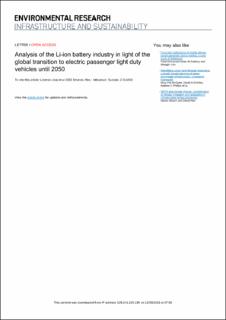| dc.contributor.author | Usai, Lorenzo | |
| dc.contributor.author | Lamb, Jacob Joseph | |
| dc.contributor.author | Hertwich, Edgar G. | |
| dc.contributor.author | Burheim, Odne Stokke | |
| dc.contributor.author | Strømman, Anders Hammer | |
| dc.date.accessioned | 2022-10-05T07:12:31Z | |
| dc.date.available | 2022-10-05T07:12:31Z | |
| dc.date.created | 2022-01-14T12:49:13Z | |
| dc.date.issued | 2022 | |
| dc.identifier.issn | 2634-4505 | |
| dc.identifier.uri | https://hdl.handle.net/11250/3023869 | |
| dc.description.abstract | The decarbonization of the transport sector requires a rapid expansion of global battery production and an adequate supply with raw materials currently produced in small volumes. We investigate whether battery production can be a bottleneck in the expansion of electric vehicles and specify the investment in capital and skills required to manage the transition. This may require a battery production rate in the range of 4–12 TWh/year, which entails the use of 19–50 Mt/year of materials. Strengthening the battery value chain requires a global effort in many sectors of the economy that will need to grow according to the battery demand, to avoid bottlenecks along the supply chains. Significant investment for the establishment of production facilities (150–300 billion USD in the next 30 years) and the employment of a large global workforce (400k–1 million) with specific knowledge and skillset are essential. However, the employment and investment required are uncertain given the relatively early development stage of the sector, the continuous advancements in the technology and the wide range of possible future demand. Finally, the deployment of novel battery technologies that are still in the development stage could reduce the demand for critical raw materials and require the partial or total redesign of production and recycling facilities affecting the investment needed for each factory. | en_US |
| dc.language.iso | eng | en_US |
| dc.publisher | IOP Publishing | en_US |
| dc.relation.uri | https://iopscience.iop.org/article/10.1088/2634-4505/ac49a0 | |
| dc.rights | Navngivelse 4.0 Internasjonal | * |
| dc.rights.uri | http://creativecommons.org/licenses/by/4.0/deed.no | * |
| dc.title | Analysis of the Li-ion battery industry in light of the global transition to electric passenger light duty vehicles until 2050 | en_US |
| dc.type | Peer reviewed | en_US |
| dc.type | Journal article | en_US |
| dc.description.version | publishedVersion | en_US |
| dc.source.journal | Environmental research: infrastructure and sustainability | en_US |
| dc.identifier.doi | 10.1088/2634-4505/ac49a0 | |
| dc.identifier.cristin | 1981161 | |
| cristin.ispublished | true | |
| cristin.fulltext | original | |

